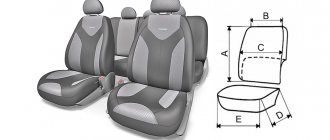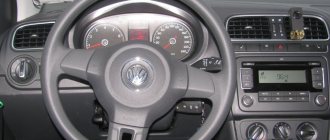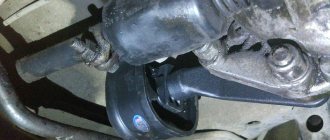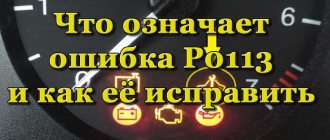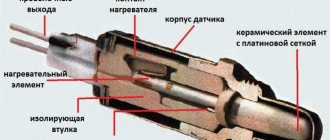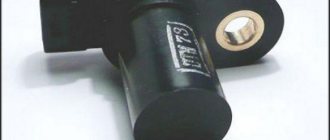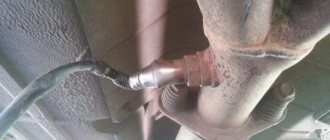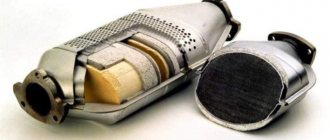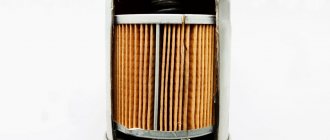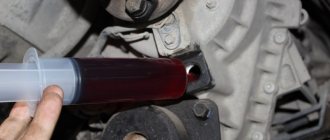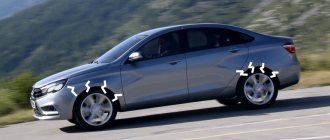Unfamiliar sounds made by the car when the steering wheel is turned (and this can be knocking, creaking, rumble, rattle, hum, etc.) do not yet mean the occurrence of a malfunction that must be eliminated. For example, cars with power steering sometimes make a very loud noise when turning the steering wheel (this is one of the specific features of some power steering). On the other hand, if instead of a hum you can clearly hear a squeak or, even more so, a knock, then it’s time not to rely on chance, but to stop by a car repair shop.
A very important thing when diagnosing a car will be whether you are able to clearly describe the nature of the sound during a turn - squealing, crunching, rumble, grinding, etc. Below we will look at the most common symptoms of such sounds and give you recommendations on how to eliminate the noise. However, you better be prepared in advance for the fact that the service master may ask you a number of things to which it would be better to answer - this will help him understand the problem. If possible, prepare answers to the following questions regarding steering noise:
- The type of sound produced (rumble/grind/crunch, etc.).
- Is the sound heard when turning the steering wheel, or under some other conditions?
- How do weather conditions, heating of steering system or suspension elements, weather, vehicle load, etc. affect the resulting sound?
- Does the car make noise when it spins in both directions or in one direction?
- Auxiliary signs or phenomena that occur with this noise.
If you are able to answer questions like these, identifying the problem and the cause of the noise will be much easier.
The front part of your car takes on a lot of different functions:
- prevents the car from leaning sideways when cornering;
- allows the wheelset to move up and down to dampen loads;
- control the direction of movement of the car using the steering wheel;
- transmits engine power to the wheels, giving the car acceleration (front-wheel drive).
As you can see, there are many factors that can influence the reduction in the service life of the elements of the front suspension and steering system. But not everything is so bad - many elements whose life is ending seem to warn the driver with strange sounds: “lubricate me,” “replace me,” “fix me.” True, such warnings almost always mean that the “screaming” part is already on the verge of wear or failure - therefore, it is highly recommended not to delay diagnostics. After all, some sounds sound like grinding, others like creaking, etc.
Below we will look at a number of typical sounds a car makes when the steering wheel is turned, as well as the factors that cause such noises. This is where the breakdown should be identified. Of course, this list is far from complete. In general, let's start the review, so read and remember well.
Rumble (steering wheel turns, car stops)
Typically, this sound is produced by the hydraulic booster, which is installed on many cars. And there is nothing scary about this noise. When you get into the car, you may feel this sound - now you know that it will appear regularly. It is extremely rare that such a sound is detected when the steering wheel is turned in only one direction.
It seems that you have become accustomed to this sound, the car has been used for a long time, but the hum becomes louder and more distinct - now it can be heard not only when turning the steering wheel in the absence of movement, but also while driving. Here, be sure to try diagnosing the power steering. The most common cause of such noise is a lack of special power steering fluid, so the problem is often solved when such fluid is added to the power steering reservoir located under the hood (it is marked with MIN and MAX marks, they mean the maximum and minimum amount of fluid). Obviously, at the MIN level, fluid is most likely leaking from the system, so after topping up, you will need to check this level for some time (at least once a week).
The noise may also be caused by a breakdown of the power steering pump, weak tension of the power steering belt, as well as air flow that has penetrated into the power steering circuit. Alas, in all these cases you should definitely contact a car repair shop.
As a rule, problems with power steering are almost always accompanied by the need to apply more force than usual to turn the steering wheel.
Why does the steering wheel jam when turning? We will fix the problem immediately. We don't need an accident
The problem with driving a car, or why the steering wheel jams when turning, for example, all the way to the extreme position, worries many car owners, both imported and domestic. The worst thing is when the steering wheel jams while driving: such a nuisance can lead the owner to the most tragic consequences, even causing an accident. Often this problem arises, so to speak, while still on the spot, without leaving the garage or parking lot, when it’s cold, when the steering wheel sticks and releases only after the engine reaches operating temperatures. Both are, in principle, solvable, but the problem needs to be fixed as soon as possible so that something irreparable does not happen on the road. Why does the steering wheel jam when turning? There may be several reasons for this. It all depends on how this happens - this is where you need to dance, trying to eliminate the obstacle to driving. Let's look at the most common options. Steering wheel sticks when cold: how to fix it? The problem is serious and unpleasant, but the solution proposed by one of the car enthusiasts is quite banal and easy. Step-by-step work is at your service! Neither replacing the pump nor replacing the fluid, as it turns out, does not solve the problem. It's all about the rack: we will subject it to some influences and improvements.
- We remove the steering rack (a lot has already been written on the topic of how to do this, so we will not delve into the process itself). Here it is in front of us - we need to put marks or take a photo (you can use your phone) of the location of the shaft. This is important so that you do not re-position the steering wheel afterwards;
- At the bottom of the rack we unscrew the aluminum muffler. A fastening nut is found underneath it. Hold the shaft with a key, twist the fasteners, and on the side of the steering shaft we find the stopper ring and remove it;
- Carefully, without extremism, remove the shaft from the rack housing (from the side of the nut);
- We carefully examine the appearance of the thread (worm) and fluoroplastic rings. We remove possible lumps and scale (especially in used cars with a significant mileage - it is unlikely that this spare part has ever been disassembled since the car was born). By the way, if the unscrewing processes are not going well, then WD-40 will help! After settling down, things will be more fun;
- The picture of the freed cavity of the rack into which the shaft enters will not be entirely pleasing to the eye: most likely, the stripes produced by the spool rings will be visually visible (the function of this spare part is to distribute fluid flows, depending on the force of rotation of the steering wheel). After a certain time, the spool rings made of fluoroplastic, which is a harder material, rub the softer aluminum cavity, forming characteristic stripes visible to the naked eye. Through these cracks, the liquid moves from chamber to chamber, and the pump pressure drops (the power steering disappears when cold);
- Professional car services deal with this problem by using sleeves and restoring the natural performance of the cameras. The option proposed in this manual is based on a different principle - a slight shift of the rings in relation to the sawn strips. For these purposes, we take a small (1-2 mm is enough, so as not to overdo it) washer of the appropriate diameter, and place it under the thread of the removed spare part. And then we assemble the rail in the reverse order of disassembly. We use marks to correctly align the steering wheel. Fill in the liquid and pump as required.
Thus, we interfere with the rack and pinion mechanism minimally: practically nothing can be spoiled.
But the effect of the procedure is enormous! The point of repair work is to move the rings using a small washer onto a flat surface that has not been worn out by them. The working chambers again become separate and do not pass between each other. It remains to be noted that such treatment is possible with an otherwise perfectly serviceable rail. But it completely eliminates the wedge when turning the steering wheel when cold. It is easy to check: the next morning the steering wheel works immediately after starting the engine - which means that all actions were carried out correctly and were successful! The steering wheel jams when turning with the ignition on. That is, it does not return back, but remains as if bitten in the extreme left or right position. And this, even at a very low speed! Moreover, if the ignition is turned off, this situation is natural for any car. But when it’s turned on... Agree, this can lead to irreparable consequences. In this case, the problem of why the steering wheel sticks when turning is to blame for a faulty switch block, the steering column. You may have to deal with the ignition switch itself. Therefore, if you are not an automotive electrician, it is best not to take risks, since it is very difficult to carry out this work yourself without appropriate training. So, we turn on the emergency lights and slowly and carefully crawl to the nearest service station, where there is an appropriate specialist. And be careful when turning: enter them smoothly, without twisting the steering wheel to extreme positions, so as not to bite again. AutoFlit.ru
Knock (steering wheel turns, car turns)
This kind of sound accompanies the car when turning. It is noteworthy that often a small turning angle and a bad road make the car make such a knock more strongly. The reason for this behavior of the car is the wear of the shock absorbers, which no longer dampen road irregularities. In this case, only replacing with new racks will help. As a rule, the axle struts have different degrees of wear, so it is likely that a knocking noise is heard only when the steering wheel is rotated in only one direction.
A knock can occur not only when turning, but also when moving straight along a poor quality road. The maximum load on the racks occurs when the steering wheel is turned, which is why the knocking sound is produced more often. Just in case, check the strut housings - they may contain oil smudges, which indicates an oil leak in the struts.
A car with a decent mileage (the word “decent” means different numbers depending on the model), the shock absorbers can fail (due to various factors). It would be useful to find out how susceptible your car is to this disease either in the official service center or in the appropriate forum dedicated to your car brand. You can also immediately go to a specialist to diagnose the racks.
Chassis, bearings and other rare crunching options
When you check all the possible causes of the crunching noise when turning, you can safely say that the problem lies only in the chassis. Of course, finding chassis problems is quite difficult; for this, it is also better to use professional diagnostics. Crunching is the prerogative of bearings, but the only type of this element in the chassis that can crunch is the wheel bearing. However, they often buzz when they fail at a certain speed rather than crunch. If you want to diagnose wheel bearings, you can do it as follows:
- lift one side of the front of the car on a jack and secure the car well with stands;
- put the car on the handbrake, and also make sure that the three wheels are firmly on the base;
- sit behind the wheel or have your assistant sit down so that he performs certain actions to spin the wheel;
- after this you need to start the car, turn on second speed and smoothly release the clutch pedal, giving a little gas;
- Please note that such actions cannot be carried out on vehicles with all-wheel drive and a locked center differential;
- after this, you need to turn off the engine and allow the wheel to spin at a fairly high speed;
- if the bearing on this wheel is faulty, it will definitely tell you about it with an abundant hum;
- If the bearing is in good condition, only the sound of friction of the metal parts of the suspension will be heard.
This is a fairly simple way to diagnose wheel bearings and will not require too much time. To implement such a test, it is not necessary to have an assistant; you can carry out all the tests yourself. To do this, you need to quickly get out of the car while the wheel is spinning. The best noise from broken bearings is heard near the wheel. However, sometimes wheel bearings make a noise throughout the garage, then it’s better to replace them before it’s too late. Completely disintegrated wheel bearings will cause serious problems throughout the entire chassis. Therefore, it is worth paying special attention to correcting problems if any. We invite you to watch a short video describing the cause and elimination of the problem with knocking and crunching when turning the steering wheel:
Knock (the steering wheel turns, but there is play)
Typically, the joints found in the steering system last as long as your car drives. However, under Russian operating conditions, faster wear is possible. Turning the steering wheel, accompanied by a faint knock at the beginning of rotation, indicates that the hinges are worn out (an increased gap has appeared). If you park the car on a level surface, then try to rotate the role from right to left, then from left to right (you need to start carefully with small movements), you can identify at what point in time the play and knocking sound appears. You can improve this method a little - open the car doors, then with the doors open, while outside the car, gradually turn the steering wheel from side to side. At some point in time, you will notice that the steering wheel rotates, but the wheels do not move - this means there is play. This backlash needs to be eliminated.
This can be done by diagnosing the hinges at a car repair shop (you need to check for wear and play), after which you need to replace the worn elements and tighten the necessary components that are causing the play.
Let's sum it up
If you think that a crunching sound when turning the steering wheel is not such a serious problem, find out the opinions of those drivers who have encountered its consequences due to poor-quality repairs or no restoration at all. After a detailed study of the problem, it turns out that you are not getting the best operating conditions for the car, and if you wait and do not repair the car, you are even exposing yourself to a certain danger. It is best to immediately find the cause of the crunching and completely correct it.
In this case, we are often talking about the safety of the trip, so the best option would be to go to a professional service station and solve all problems by installing factory spare parts. A crunching sound always means that a specific control, chassis, or other components have broken down. Therefore, do not think that this manifestation will go away by itself. Just keep yourself safe and gain more confidence on every trip. What problems have you experienced that resulted in a crunching sound in the steering area?
Grinding, as well as squeaking (the steering wheel turns both when driving and when standing still)
A grinding/creaking sound that is felt when the steering wheel is turned in different directions. This noise occurs due to wear on the suspension joints or steering joints. Similar to the previous point, here you will need to diagnose the suspension components or steering system, replacing worn parts, if necessary.
However, the most common reason for such a sound is the lack of lubrication in the steering tips (as well as their severe wear).
Thanks for subscribing!
Sometimes such a squeak can even be accompanied by a crunching sound, regardless of whether the car is moving or standing still. In this case, the culprits are the lower ball joints (sometimes the shock strut bearings). The first option is also accompanied by play in the steering wheel when the car is suspended.
Silent blocks crunch
This is a common malfunction of rubber-to-metal joints, especially in hot summer weather. At elevated air temperatures, silent blocks may creak, which indicates the need to check and replace them.
The creaking or crunching of silent blocks on a summer day occurs due to drying out of the hinges. The main material of these units is rubber. At elevated temperatures, it dries out and decreases in volume, especially if these nodes are already old.
There is no particular danger in the crunching of silent blocks until the rubber breaks. It is necessary to remove the silent blocks and carry out a visual inspection. If cracks or damage are found, they should be replaced. If no problems are found, then they should be put in their place and continue to enjoy driving the car, hoping that soon the air will become cooler and the squeak will disappear.
Shock absorbers (struts)
If you take a classic VAZ 2101 - 2107 car, then either the shock absorber itself (strut) or its mounting location may knock, provided that the bracket is released.
The lower silent block of the shock absorber may also knock.
If the strut is unscrewed at the top or the upper bushings are worn out, this can also lead to knocking noises on bumps.
Pay attention to the spring; if it is broken, knocking noises will be heard due to the coils playing with each other; this is also typical for other car models. As for shock absorbers VAZ 2108/09/10 and above, a slightly different picture emerges here
As for shock absorbers VAZ 2108/09/10 and higher, a slightly different picture emerges here.
If the supports and ball bearings are intact, and the sound comes from the strut area, then it is possible that the shock absorber nut is knocking, especially on bumps.
Those. A small gap may form between the nut, strut and shock absorber, which will lead to knocking.
To solve this problem you need to tighten the nut. To do this, jack up the car and insert a wooden stop between the disc and the side member to prevent the wheel from spinning.
Lift the corrugation and lubricate the threads of the rack with oil (can be worked off).
Take a number 3 gas wrench and use it to tighten the nut. Use a pipe for leverage.
Well, check the rack for leaks; if it is broken, it can also knock.
If two front struts are broken, then during sharp braking the car will nod off, and when accelerating, the front end will lift up.
How to repair a CV joint
Damage to the internal parts of the hinge most often leads to a complete replacement of the mechanism. However, this only happens with significant wear. In most cases, it is recommended to simply replace the CV joint grease and boot. This is often enough to get rid of the annoying sound and make it easier for the parts to interact.
Therefore, if knocking or clicking sounds appear on one of the four CV joints (we will assume that you have already found out which one), you must perform the following steps:
New inner CV joint
- Drive the car into the inspection pit in order to check the integrity of the boots and the presence of lubricant splashes from under them on nearby surfaces.
- If traces of grease are visible on the boot or other parts, it is necessary to remove the CV joint. Next, disassemble it, remove the boot, wash the internal parts and surfaces, change the lubricant and boot.
- If during the inspection process you find significant play and/or damage to the working surfaces of the parts, you can try to polish them. However, as practice shows, this procedure is ineffective, since you cannot eliminate significant waste with anything. Therefore, the best recommendation would be to completely replace the CV joint .
You can replace the lubricant and boot yourself, as the procedure is simple. The main thing is, when disassembling, do not forget to wash all internal parts and surfaces with gasoline, thinner or other cleaning liquid. And only then apply new lubricant. However, if you are dismantling and replacing the lubricant for the first time, then it is better to have a more experienced car owner or technician with you. Or have him perform the procedure and show you its algorithm. In the future, you can easily cope with such work.
Conclusion
Constant velocity joints are reliable and durable mechanisms. However, during operation, it is necessary to constantly monitor their condition in order to determine in time which CV joint is crunching or making other unpleasant sounds. After all, this indicates a malfunction in its operation. Hinge failure at the initial stage is not critical . You can drive hundreds or even a thousand kilometers with a crunch. However, you should remember that the sooner you repair or replace the CV joint, the cheaper it will cost you. In addition, do not forget about safety. Do not bring the condition of the hinge to a critical state , as this threatens you with a serious emergency situation, especially at high speed. We hope that the above information helped you figure out what to do when the CV joint crunches and accurately determine which one is faulty.
Tags: Priora sedan
Comments 25
listen, what kind of photo is this?
Thanks everyone, I fixed everything, it was a matter of loose bolts near the wipers, tightened it up and everything was quiet)) once again, THANK YOU all so much!
For 2 months I racked my brains and eliminated my suspicions (I glued the pillar, took off the mirror, re-glued the door trim, smeared the awnings) and, strangely enough, all this helped for 5, 10 minutes of driving and again a pain in the ass, until I tightened the screws securing the plastic under the wipers and now the miracle has happened - the long-awaited silence
Got it, thanks, I'll give it a spin! =)
I also had sound in this place, sometimes there, sometimes not. I was scratching my head about what it could be, but it turned out that under the hood, in the area where the support is screwed on, there is a tube, or rather two, there is a clamp on it and on this clamp there is a bolt, and so it was rubbing against the iron from where the stand with the support comes out. I filed the bolt and everything was gone - now there is silence.
but I don’t have a photo where I can even look, but I’m just not good with cars! Visually, I should at least look where to look!
a friend of mine removed the glass and put me new velvet covers from some foreign car under the door trim; they press the glass tightly and don’t scratch
I understand, but could you find out from which one if it’s not difficult?
on Priora they are on sale for 500 rubles 4pcs
The noise I had on this side was coming from the mirror (I fixed it) the noise on the same side was when the window was open and the glass was hanging (it was fixed) the noise from the side of the shell was rubbing against the dashboard when it was closed (I fixed it) the right pillar rattled in it, plastic clips were placed through the seal ( fixed it) but most importantly, the door itself as a whole was rattling and rustling and the sound was coming from the top of the torpedo, it glued the whole door, there was deathly silence)
Wow, the robots have done a lot of work! Thanks a lot!
The noise I had on this side was coming from the mirror (I fixed it) the noise on the same side was when the window was open and the glass was hanging (it was fixed) the noise from the side of the shell was rubbing against the dashboard when it was closed (I fixed it) the right pillar rattled in it, plastic clips were placed through the seal ( fixed it) but most importantly, the door itself as a whole was rattling and rustling and the sound was coming from the top of the torpedo, it glued the whole door, there was deathly silence)
How did you fix the problem with the glass that they were hanging out?
well, it’s on clips, pry it off with a screwdriver and that’s it
It was on this side that the pillar panel creaked for me. It touched the bottom of the torpedo and made an terribly disgusting sound. It helped to tuck a folded piece of paper in there =)
+1 I had this happen too, I cured it with a small piece of madeleine
ugh, fuck, I look at the main photo and think: “this is a dude, he cut off the roof for the sake of a squeak. can we make a convertible?” It’s a good thing I looked at the floor, otherwise I would definitely have been constantly analyzing this thought))
There is the same problem, only this sound may not be there for a couple of months, then it will be fixed for a day and again there will be no sound for a week, but it is not constant, so I did not look for the reason, but I will take note of the comments)
I also got it not so long ago, but it’s just terrifying! =)
In general, I had a problem from the street about the windshield, plastic scuffling in the lower corner!
Communities › Lada Priora Club › Blog › Eliminating noise and squeaking in the trunk
Good day.
I haven’t written on this blog for a long time, but now the reason to write was born.
I hasten to share with my comrades who have wonderful
hatchback body how to partially eliminate noise in the rear of the car.
Actually, I can’t say that it’s really noisy, but personally, I didn’t experience a real rattle. It is not too noisy, but is constant while driving. I couldn’t understand what was wrong, but the issue was resolved.
For those who have a creak.
The issue was resolved with tie rod plugs from a VAZ 2108, I bought two of them for 25 rubles apiece.
For those who constantly have something rattling.
I couldn’t understand what was rattling, I touched everything.
I rewound all the wires in Madeleine/Bitoplast. It started creaking, I removed the bitoplast, it really creaks, don’t use it! It doesn't even squeak as much as it rubs; in general, the sound is not pleasant.
Let's return to the fact that everything is wrapped in madeleine, everything is tightly planted, the shelf is checked forty times, and then completely removed.
It's not about the shelf! This is what I found out. Not in wires. I removed all the plastic from the back. And it turned out that it wasn’t him. Everything is as always in the trunk lid. Noisy father
by her leg.
Then a suggestive moment happened:
I was putting the bags in the trunk and
BAAAAH
, Tyson himself hit me, I immediately spat out my false jaw,
NICHOSI
, the stops don’t hold, and the trunk weighs a ton no less... such things, but I have it
welded and glued
. After that decided not to delay and buy stops.
I drove everywhere until I found Fenox for 2112, it has the highest pressure, judging by what Google told me, 460H. Two pieces for 498 rubles each. I already had ones from 2112, because... they are more powerful than on 2170. There was pinzes on the street:
